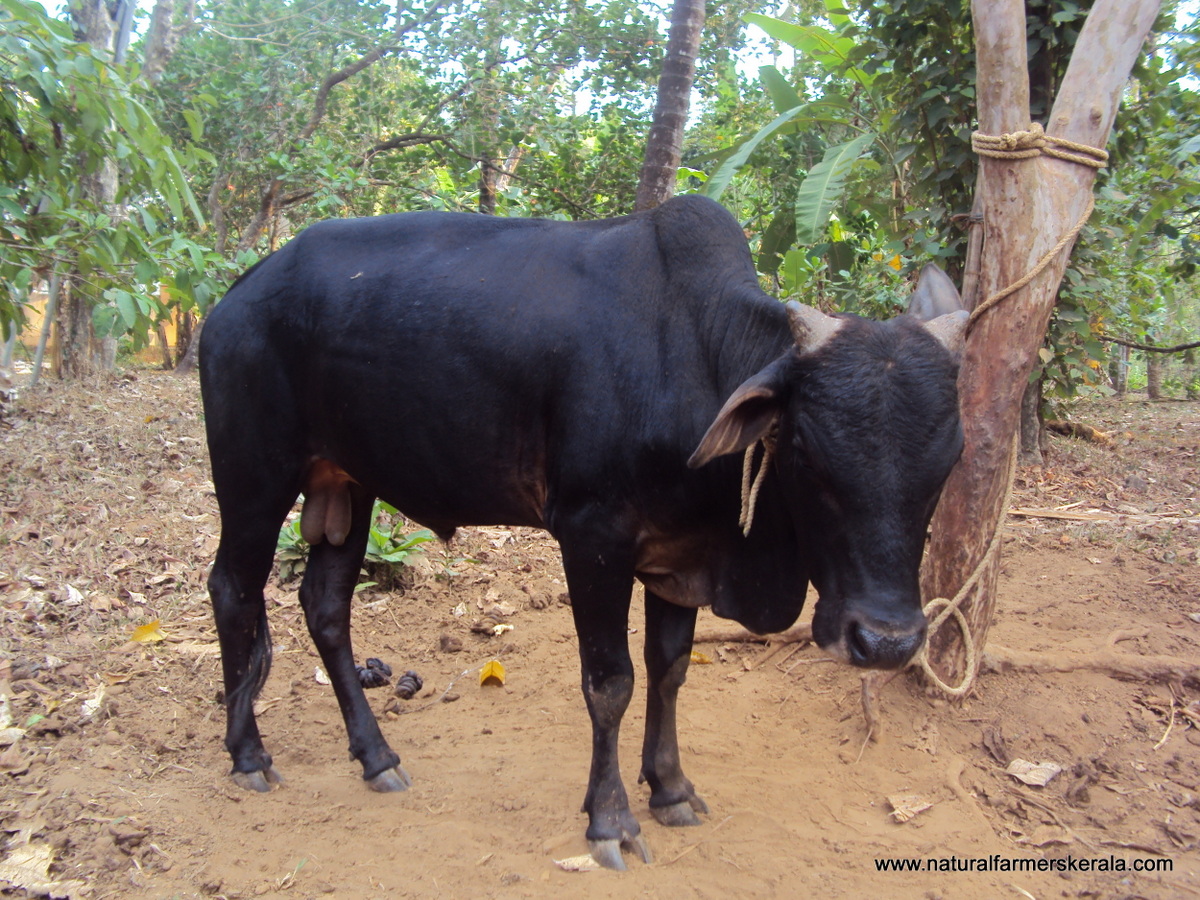The cock and bull story of Kerala’s cattle-development policy – Part 2

This article is continuation of The cock and bull story of Kerala’s cattle-development policy
Brazil has turned to the traditional Indian way of cattle rearing, after a lot of research. 80% of their cattle comprise of Indian Breeds. They also favour natural breeding using bulls, let cattle graze instead of stall feeding ,as this was learnt to be the most effective way of rearing.
Vechur Cows contaminated with Jersey and Swiss Brown
Anxious to cover-up, in the wake of the new findings, the Dept and it’s babus started a conservation plan for the Native breed. Accordingly, the Vechur, a dwarf breed of Southern Kerala was decided to be saved. What followed was a farce. 30 animals that were closest to the Vechur were identified. Note that pure Vechurs were gone; the ones closest to the Vechur were the 70-80% Vechurs with a 20-30% Jersey or S.Brown mix. These 30 animals were taken and further bred using AI. 5-6 generations down all the progeny looked standard for the simple reason that they were all repeatedly inseminated using the same semen sample! This is the much hyped about Vechur breed of Kerala now!
To date the same policy is followed. Vechur bulls selected for semen-collection are maintained for 5 years, then sent for killing and replaced by another lot. For a period of 5 years all the Vechur Cows in the country get inseminated by the semen from the same set of bulls. How can breed selection and improvement happen?
The only breed in Kerala that is pure and remains untouched is the Kasaragode Dwarf breed. There are farming communities in the remote areas of Kasaragode who were not greedy and hence not tempted by the promises of Jersey/Swiss Brown/Holstein revolution. In these communities, the cattle breeds are part of cultural heritage, and people remained staunchly committed to their breeds. These breeds have been in existence for at least 150 years. Cattle are members of their family and care is taken not to let in-breeding happen. These cattle have amazing qualities and attributes, are extremely intelligent, hardy and interact with humans beautifully. The milk from these Cows has been tested and found to be the finest in the world. It’s got a higher ratio of digestive enzymes and can be substituted for mother milk for orphaned infants.
Page 2, The first mentioned among the Functions and Duties of the Organisation is
Strengthening the livestock population of the state both in terms of number and quality”.
“How can this be possible without strengthening the native breed population along with improvement of the breed? Obviously the strengthening of population happens only with the hybrid breeds, no such measures have taken for the native breeds. If quality of animal and milk is a criteria nothing comes close to the native breed.
Similarly, Page 3, No.9 of the stated objectives of the Department is “to conserve local breeds pertaining to livestock and poultry farming”
Now, how can conservation of local breeds be legal as well as practical with Livestock Improvement Act 1961 still in force? Breeds cannot be saved without Bulls, since bulls capable of reproduction are illegal; conservation also becomes an illegal activity! How can conservation be done by the public without bulls? The 1961 Act works against the stated objective of conservation and is a hindrance to proper conservation.
Take conservation of local breeds, whether Department led or otherwise; Where, why and how does anyone get the first specimen to be collected? If the KLD Improvement Act 1961 was implemented and enforced to 100% efficiency, no local Cow or Bull of would have survived; technically no local breed should be available for conservation. Here conservation became reality only because of the violation of the 1961 Act.
As for the intentions of the AHD, Kerala, it is reminiscent of the Taliban – Buddha Statue episode of 2001. For those who can’t recollect the event- The Hindu-Kush mountains of Afghanistan, housed two 150 ft tall Buddha Statues that were 1700 year old archeological monuments. Taking exception to anything that was foreign to their culture, the Taliban tried to destroy it by anti-air craft and tank fire. These bids failed. But the rest of the world pleaded on bended knees to spare the cultural/archeological treasures. Several offers were made, assuring the Taliban that if the statues offended them, they could be removed and relocated out of their country in shortest possible time. The UN intervened, Kofi Annan, the then UN Secretary General met the Taliban Foreign minister and pleaded that the statues not be destroyed. The Taliban were unmoved or rather moved to the extreme. Possessed with the power to bully the rest of the world, the Taliban did the only thing they were capable of doing. In what was complete justice to their brains, they drilled holes throughout the torsos of the statues, filled dynamite in them and blew them up in such fashion that not even the remains of the statues could be of use to the rest of the world.
Kerala Livestock Development Improvement Act Destroyed Native Cattle
The 1961 KLD Improvement Act ranks a more shameful crime than the Taliban one. The Taliban destroyed what they believed was an alien heritage, but the Kerala AHD had no qualms destroying Kerala’s own heritage sitting in Kerala, right in front of it’s people.
The trends in the worldwide cattle scene are fast changing. Now everyone is shifting to Bos Indicus. 70% of Brazilian Cattle population is now made up of the Indian breed, Gir. New Zealand also plans to move to Indian breeds in big way. Indian breeds are picked up at a premium by breeders from overseas. The Gir which costs about 50,000/- to 60,000/- in India is bought at Rs2,50,000/- by the western countries. Gujarat has already banned export of the Gir. Similarly the Ongole (from which the famous American Brahman breed was derived) is picked up at 5 lakhs per pair. As I am typing this, the Kerala Govt/AHD Dept is working on a scheme. Guess what? Importing bulls from France to improve the milking breeds in Kerala!
Talk of shamelessness, and then crops up this old Malayalam saying, which I am not going to reproduce here for obvious reasons. To give you a milder interpretation of it – There’s this good-for-nothing person who is sitting and doing nothing. Meanwhile a Pipal starts germinating on his backside. Now, you’d expect this person to get up embarrassed and remove it at once. Instead, he just chooses to sit there flaunt it as a decoration, and wants to let it grow, hoping to make use of it’s shade and cover. Can you beat this?!! Now, no one can live upto this saying as much as the Kerala AHD Dept.
One need not be Doctor, dietician, nutritional specialist to lead a healthy life, similarly one need not be an agricultural scientist to grow a good home garden, neither does one need to be an Institution, Specialist or Veterinary expert to develop and maintain a good cattle breed. Forget what the State or AH dept tell you, just get a group of like-minded people, adhere to the traditional wisdom of breeds and selection, be passionate about your breeds, hold them close to your heart and provide them with lots of love; they will reciprocate several fold.
Credits & References
- Some glaring contradictions of the Kerala AHD Policy – http://ahd.kerala.gov.in/docs/rti_2_3_12.pdf
25 Replies to “The cock and bull story of Kerala’s cattle-development policy – Part 2”
Comments are closed.






Namaskaram
Very foolish act which destroyed our native breeds and killed farming in Kerala. My grand parents were farmers and I have seen farms in Kannur (Kerala ) in my childhood i.e. 1987-88. We had 3 cows, today all houses every where. No farms and today all existing breeds are western and I do remember my grandmother my grand mother talking about artificial insemination as no bulls out there.
Just wanted to check with you how can we remove this act and save and improve the existing live stock and bring back farming.
Babita Rajan
Its possible to keep bulls illegally in Kerala.
As veterinary dept don’t make a fuzz about it nowadays. But if every where it starts then the veterinary dept will start messing up as AI and other allied activities are their source of lively hood and job now.
I don’t see anytime soon Kerala cow and bull rearing culture getting back in shape. As people have gone. Younger generation is least bothered. Its difficult with out mass movement.
Thank you for the reply sir. It was nice to see the jallikattu movement, wish Kerala youngster shows such keen interest in natural farming. But unlike tamilnadu in Kerala agro lands are also less.
Regards,
Babita